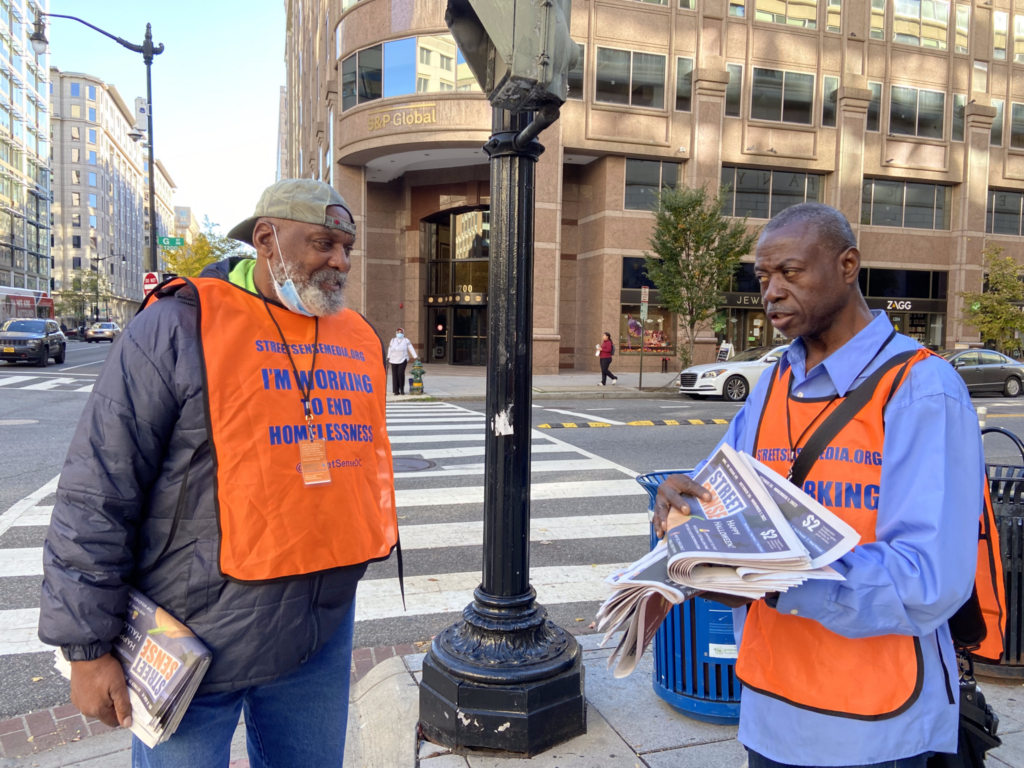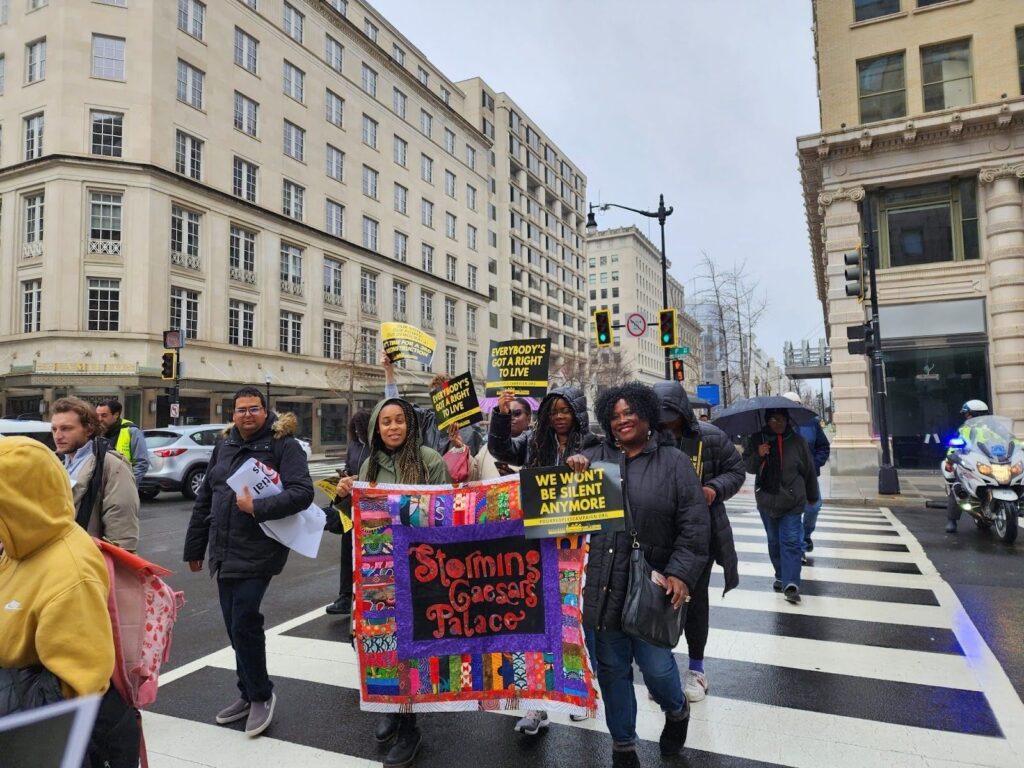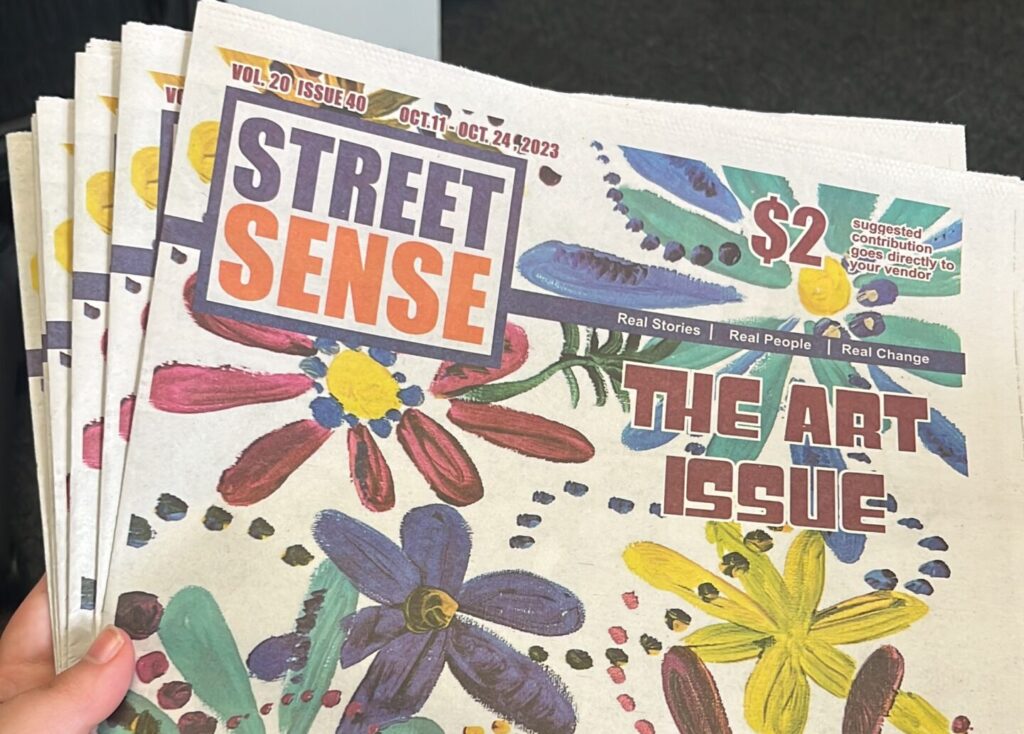It’s around 9 a.m. on a Sunday morning and Aida Peery, 66, is bundled in a gray hoodie and knee-length purple coat, folding stool over one arm, pushing a stroller filled with canvas tote bags and a bundle of newspapers. She’s on a mission. Today, she plans to sell 50 papers.
For the past 18 years, Peery has sold newspapers to supplement her income. She works as an independent contractor for Street Sense Media, a nonprofit in Washington, D.C., that produces a weekly paper filled with art and journalism. Most of the vendors who sell the paper have had some experience with homelessness. Peery started at Street Sense when she fell behind on bills while caring for her partner, who developed lung cancer and died. Today, she lives in a subsidized apartment.
With a master’s degree in information systems, Peery is also a member of the paid staff at Street Sense Media and coordinates sales of the paper to vendors. Still, she finds that selling the paper on weekends is an easy way to make some extra cash and to keep up with old acquaintances.
She makes her way past a florist, colorful displays of fruits and vegetables, and about a dozen food stalls pumping out coffee, bagels, croissants, and other baked goods before she finds her way to her usual spot. It’s at the end of a parking lot at a farmer’s market at the intersection of 20th St and Massachusetts Ave. in a neighborhood in Northwest Washington, D.C. The sky is clear, cerulean. Standing at the edge of a labyrinth of stalls, where hundreds of people are streaming through it, she reflects on the way the pandemic had changed everything.
“Everyone wants to go to the smaller Saturday markets,” Peery says. “I run into my customers there sometimes. They say they don’t like the crowds. Besides, it’s gotten too expensive. It’s all tourists now.”

Selling newspapers in a time when newspapers are dying
For nearly 20 years, vendors from Street Sense Media have sold newspapers outside Metro stations, farmer’s markets, and heavily trafficked intersections as a means to make an income. They buy the papers wholesale for 50 cents a piece and sell them for $2, keeping all the profits for themselves.
I became the editor in chief for the paper in December 2021, following an incredibly challenging time. In March 2020, print sales fell to zero as the organization temporarily shifted all of its operations online due to the pandemic. After resuming print publication, Street Sense made the move from publishing the paper twice a month to weekly, in an attempt to help our vendors recuperate lost income stemming from the changing commuting habits of their customers.
In 2021, we also began paying our vendors for all their published editorial contributions and writing, a necessary move also intended to help increase their income. (Previously, vendors received free papers in exchange for their work).
The new challenges brought on by the pandemic also came during a time when less people feel inclined to read newspapers. In 2019, the local Express newspaper run by The Washington Post that was distributed for free for 16 years on the Metro stopped printing, citing financial issues. The following year, the city’s alt-weekly newspaper, Washington City Paper, transitioned from printing weekly editions to monthly editions due to declining interest induced by the pandemic. By 2022, it stopped publishing print papers altogether and reduced its editorial staff.
Vendors were able to recuperate up to 75% of the sales volume they made pre-pandemic in early 2021. But it has since reached a plateau. Part of the stagnant sales is due to forever changed commuting habits. Many federal government and private sector office workers used to commute in-person to their offices downtown, but have since shifted permanently to remote working. However, this year we’ve begun to finally see a new upward trend. Even as January and February tend to be low sales months, overall volume is increasing thanks to the launch of a new sales contest.

Inside Street Sense Media’s 2023 sales contest, the ‘Sell-a-Thon’
Consulting with a group of long-time vendors, Thomas Ratliff, our director of vendor employment at Street Sense Media, began considering reviving an old idea.
Years ago, Street Sense Media used to host a monthly sales contest that awarded the vendor with the highest grossing sales with a cash prize. Aside from the gratification of winning an additional monetary bonus, the contest also came with its own bragging rights. However, this year’s contest, which is set to continue throughout the year, follows a different model.
It is designed around a point system to account for the top-grossing and most improved sellers. Since vendors keep all the profits from sales of the paper to themselves, Street Sense is unable to keep track of how many papers vendors actually sell. Instead, the nonprofit keeps track of the number of papers they purchase, which suggests sales. But this is not the only way vendors receive papers. They also receive free copies of the paper for many activities, including attending workshops, receiving a Covid-19 vaccination, or achieving something special such as finding a new job. These papers are also included in the calculation to determine the top vendors for both categories.
However, early on, Ratliff realized there would need to be a third variable to balance out the points received by vendors who followed different strategies for selling.
“We have a few vendors who were actually relatively engaged with their customers and get a lot of the incentive papers. But we also have vendors who only buy papers from us and go out and sell us papers and don’t come to our workshops,” he told me.
To encourage both groups another opportunity to score points for the contest, he introduced a third element known as the “customer kudos.” If a vendor manages to convince a customer to call or write to Street Sense Media, they earn extra points for the sales contest.
Making sales is harder than it looks
On her first day, new vendor Josie is standing on the corner of 11th and G Street. Northwest, learning the basics of the business from two longtime vendors James Davis and John Littlejohn. Like most newcomers, she is a little apprehensive and nervous. She is also eager to make sales.
Amid the din of traffic and people in suits and zip-up Patagonia vests, AirPods plugged into their ears, stare at their phones and pass by, Davis and Littljohn give her helpful advice. “Customers are not going to come to you,” Littlejohn says, “You got to go to them.” The pitch — whatever slogans a vendor uses to attract customers — he says should be focused on something beyond selling the paper. Instead, Littlejohn says it’s important to emphasize “the movement.”
“That helps them feel special because they’re now a part of something,” Davis chimes in; whatever you want to use as a pitch, the first rule is that you must say something to make a sale.
Davis has trained many vendors in the art of making sales since coming to the organization in 2003. Boasting a personal best sales record of 1,925 papers in a month in 2007, Davis is one of the best. The crew sets up along a bustling intersection a few blocks from the White House at 11th and G St Northwest. Each person takes a corner of the intersection. “Stay closer to the end of a block,” Davis says, “it’s better because you get more foot traffic.”
Obvious tourists – parents with children, a group of teenagers staring at their phones, and a couple on a scooter zip by in the opposite direction of the National Mall and the monuments. Josie waves at each person; makes eye contact, and says “Hello,” as she gives her sales pitch. Self-doubt is in the air, it’s palpable.
Davis says that if there is a single reason why a new vendor fails, it’s because they give into it. “Do you know how many game-winning shots Michael Jordan made?” Davis asks. “Less than the number of game-losing shots he made.” Part of being a vendor, he says, is learning to look past the challenges. “You’ll make a sale, don’t worry about it.
Josie closes out the day with a smile after making her first couple sales.

Persistence is key to selling
It’s been an hour, and Peery has yet to make a sale. Yet, she’s unfazed. A long time vendor, Peery understands the importance of location. She trusts the process.
Michele Rochon, a longtime Street Sense vendor, who’s made it to this month’s top ten most improved seller’s list, says that many newcomers can feel discouraged after spending hours on end without making a sale.
“If you’re not selling anything where you are, you need to move,” she says. “I’ve been out to Reston and Tyson’s Corner (suburbs of Washington, D.C.) selling the paper.”
Recently, Rochon says she was out selling papers in a new location, a suburb, when a man inside the top of an office building peered out his window and saw her waving the newspaper. He came rushing out of the building and breathless, told Rochon, “You don’t know how long I’ve been waiting to see a vendor. Are you going to be back?”
However, even seasoned vendors such as Rochon run into difficulties. Once in 2021, she says she spent an entire day where she made no sales. She was ready to give up, but then a voice inside her encouraged her to go back to a previous location near a retail store where she met a customer who bought all 20 copies of the paper she was carrying.
Before long, Peery moves her spot. She makes three sales within minutes. Two of them are regulars. One is a tourist from Colorado, intrigued by the idea of street papers. Most of her customers, she explains, are people she has known for years. She finishes her day 25 papers short of her 50 paper goal.

Winning strategies
For Abel Putu, the vendor with the top-grossing sales from February, the Street Sense newspaper is a primary platform for raising awareness on an issue that is close to his heart — wheelchair basketball.
He uses every opportunity possible to inform his customers about the latest developments in the sport. It is also what he spends most of his time writing about. Having this passion, he says, also helps him with closing sales with his customers who are also interested in learning more.
Putu, who received by far, the highest number of “customer kudos” points than any other vendor, likened the sales contest to a political election. He says he approaches his sales like a politician would a campaign. At each opportunity, he seeks to raise awareness amongst his customers about his campaign to bring back wheelchair basketball to D.C. The paper offers him a means to do this.
But when it comes strictly to matters of winning contests – no matter whether they are in politics, sports or sales – Putu says it all boils down to combining the right ingredients.
“The way you act, the way you behave, the way you show character, your personality, because personality wins the game,” he says. You got to win a game before you can win a championship and I’m going to win it again this month,”
Corey Sanders, the vendors with the most-improved sales from last month, never thought he stood a chance at winning.
“I was nervous because there’s just so many people that sell the paper,” he says. But in the end, he says that he pursued a strategy much similar to that of Putu.
While many people approach sales from a strictly economic standpoint, trying to convert customers to make cash; Sanders says that he finds much more success when he “speaks from the heart” and explains to people what he’s trying to accomplish.
He credits the contest with helping motivate him with a newfound purpose. “It really showed me how much I could do,” he says.
Editor’s Note: Nearly 10 years ago, Street Sense volunteer editor Jonathan Comer chronicled his experience selling newspapers alongside vendors for a day in an article published on Nov. 16, 2013. This article is inspired by the earlier version.








